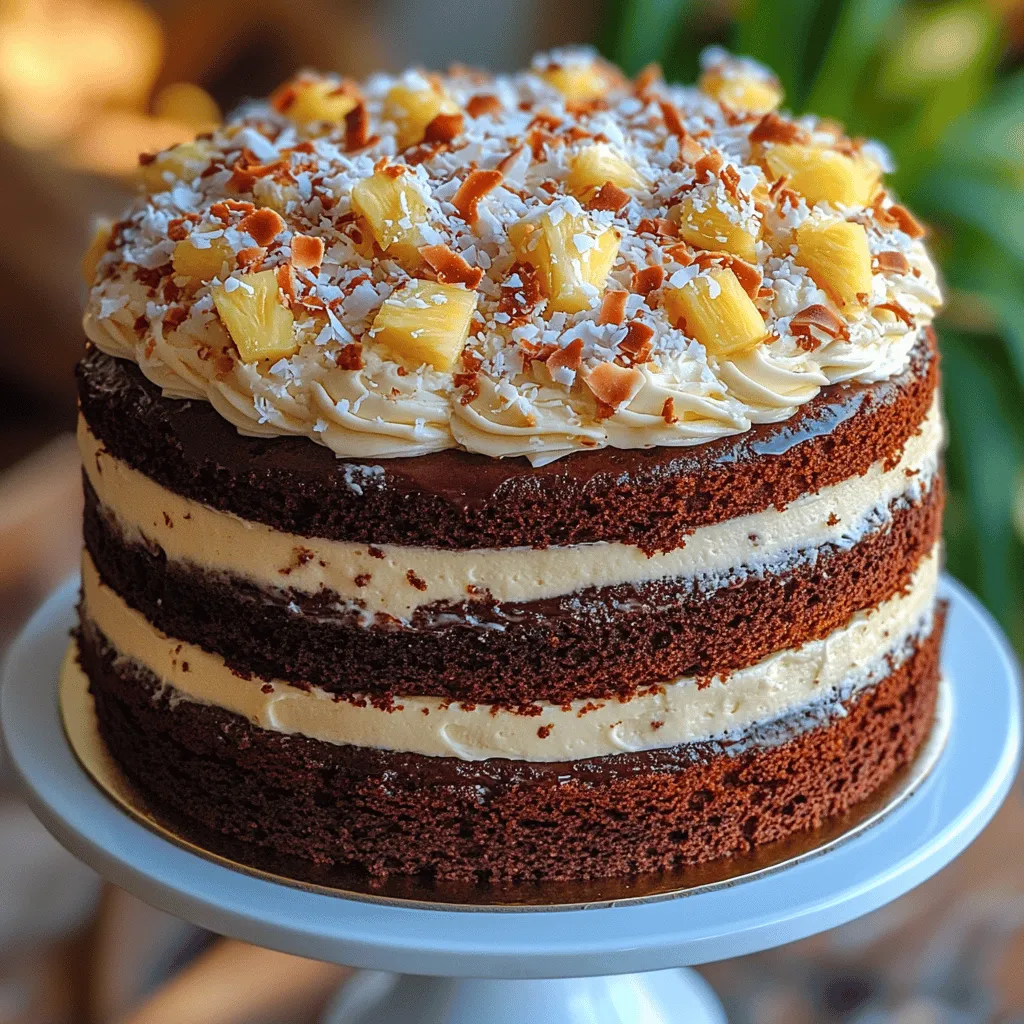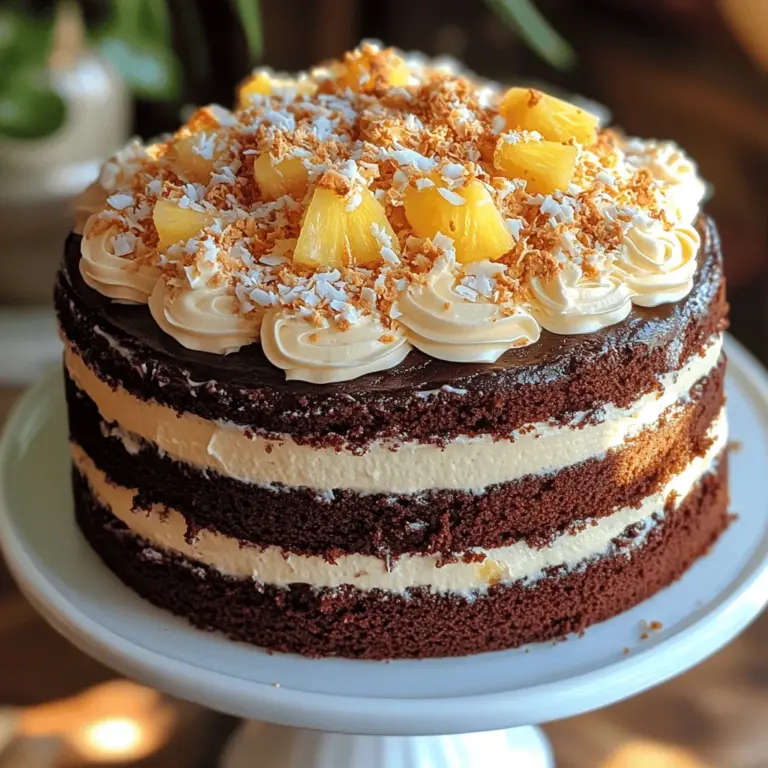Introduction
Welcome to a slice of paradise! The Tropical Paradise Cake is not just a dessert; it’s an experience that transports your taste buds to sun-kissed beaches lined with palm trees and the soothing sound of waves crashing against the shore. This delightful cake embodies the essence of summer with its rich tropical flavors, combining the sweetness of pineapple, the creaminess of coconut, and a hint of cocoa to create a unique and refreshing treat.
As the temperature rises, the quest for the perfect summer dessert begins. Whether you’re hosting a backyard barbecue, celebrating a birthday, or simply satisfying a sweet tooth, this cake is the ideal choice. Its vibrant flavors are not only perfect for summer; they also add a festive touch to any occasion, making it a favorite among friends and family. With every bite, you’ll find yourself reminiscing about tropical vacations or dreaming of future getaways.
In this article, we’ll guide you through the ingredients that make this cake so special and take you step-by-step through the baking process. With our detailed instructions, you’ll be able to create a show-stopping dessert that’s both impressive and delicious.
Understanding the Ingredients
A successful cake relies heavily on the quality and combination of its ingredients. Let’s take a closer look at the key components that give the Tropical Paradise Cake its unique flavor profile and texture.
All-Purpose Flour
All-purpose flour is the backbone of any cake, providing the structure and support needed to achieve the perfect rise. Its moderate protein content strikes a balance between tenderness and strength, allowing for a light and fluffy cake without compromising its integrity. When measuring flour, it’s crucial to use the spoon-and-level method, ensuring you don’t pack too much into your measuring cup, which can lead to a dense cake.
Granulated Sugar
Sugar is the key to sweetness, but its role goes beyond just flavor. Granulated sugar helps to aerate the batter during the creaming process, contributing to a lighter texture. It also aids in moisture retention, resulting in a cake that stays fresh longer. For the Tropical Paradise Cake, the right amount of sugar enhances the natural sweetness of the pineapple, creating a harmonious balance.
Unsweetened Cocoa Powder
While cocoa powder might seem like an unusual addition to a tropical cake, it serves an essential purpose. The unsweetened cocoa powder adds depth and richness to the cake, complementing the fruity flavors without overpowering them. The chocolate undertones create an unexpected yet delightful contrast, making each bite a journey of flavors.
Baking Soda and Baking Powder
These two leavening agents are essential for achieving the perfect rise in your cake. Baking soda is a base that reacts with acidic ingredients (like pineapple juice) to produce carbon dioxide, which helps the cake to rise. Baking powder, on the other hand, contains both an acid and a base and is designed to work in two phases—once when mixed with wet ingredients and again when exposed to heat. The combination of these two leavening agents ensures a light and airy cake.
Coconut Milk
Coconut milk is a star ingredient in this cake, contributing both moisture and a rich tropical flavor. It gives the cake a subtle creaminess that pairs beautifully with the other ingredients. For the best results, opt for full-fat coconut milk, which yields a richer texture and enhances the cake’s overall flavor.
Eggs
Eggs play a crucial role in binding the ingredients together while adding moisture. They provide structure and stability, allowing the cake to hold its shape as it bakes. For optimal results, use room temperature eggs, as they blend more easily into the batter, ensuring a smooth and consistent mixture.
Crushed Pineapple
Crushed pineapple is the pièce de résistance of this cake, infusing it with a burst of tropical flavor. Not only does it add sweetness, but it also contributes moisture and a delightful texture. When using crushed pineapple, be sure to drain it well to avoid excess liquid that can affect the cake’s consistency.
Ingredients for the Coconut Cream Frosting
The Tropical Paradise Cake is elevated further with a luscious Coconut Cream Frosting that complements its flavors perfectly. Let’s look at the key ingredients for this indulgent topping:
Heavy Whipping Cream vs. Coconut Cream
For a rich and creamy frosting, you can choose between heavy whipping cream and coconut cream. Heavy whipping cream creates a light and fluffy frosting, while coconut cream adds an intense coconut flavor. If you prefer a dairy-free option, coconut cream is the way to go. Whipping either option until soft peaks form ensures a light and airy frosting that spreads easily over the cake.
Powdered Sugar
Powdered sugar is essential for achieving the right consistency in frosting. It dissolves easily and provides sweetness without adding graininess, resulting in a smooth texture. Adjust the quantity based on your desired sweetness and thickness.
Toasted Coconut Flakes
Toasted coconut flakes not only enhance the flavor of the frosting but also add a visually appealing garnish. Their crunchy texture contrasts beautifully with the smooth frosting, making each bite a delightful experience. Toasting the coconut brings out its natural sweetness and adds a nutty aroma that elevates the overall taste of the cake.
Step-by-Step Instructions for the Tropical Paradise Cake
Now that you have a thorough understanding of the ingredients, it’s time to roll up your sleeves and get baking! Here’s how to prepare your Tropical Paradise Cake step by step.
Preheating the Oven and Preparing Cake Pans
Start by preheating your oven to 350°F (175°C). This is a crucial step, as a properly heated oven ensures even baking. While the oven is warming up, prepare your cake pans. Grease and flour two 9-inch round cake pans to prevent the cake from sticking. Alternatively, you can use parchment paper to line the bottom of the pans for easy removal.
Mixing Dry Ingredients
In a medium bowl, whisk together the all-purpose flour, unsweetened cocoa powder, baking soda, baking powder, and salt. This step is important for ensuring that the leavening agents and salt are evenly distributed throughout the flour. Properly mixing these dry ingredients will help the cake rise evenly, resulting in a uniform texture.
Combining Wet Ingredients
In a large mixing bowl, combine the granulated sugar and room temperature eggs. Using an electric mixer, beat them together until the mixture is light and fluffy. This process incorporates air into the batter, which is essential for lightness. Gradually add the coconut milk and crushed pineapple, mixing until well combined.
To achieve a smooth and lump-free batter, it’s essential to ensure that your ingredients are at room temperature. Cold ingredients can create a lumpy texture that affects the final product.
With these initial steps, you’re well on your way to creating a fabulous Tropical Paradise Cake that will impress your guests and satisfy your cravings for tropical flavors. As you continue through the mixing and baking process, keep the spirit of summer alive, and enjoy the delicious journey of creating this delightful dessert. Stay tuned for the next part, where we’ll delve deeper into the frosting and assembly of this tropical delight!

Merging Wet and Dry Mixtures
Once you have prepared your wet and dry mixtures for the Tropical Paradise Cake, it’s time to combine them into a luscious batter that will form the base of your cake. Begin by pouring the wet ingredients into the bowl containing the dry ingredients. Use a spatula or a wooden spoon to gently fold the mixtures together. The key here is to mix just until all the dry ingredients are moistened; overmixing can lead to a dense cake.
Tips on Folding Techniques to Avoid Overmixing
When folding, use a gentle motion that lifts the batter from the bottom of the bowl and folds it over the top. Rotate the bowl as you fold to ensure even mixing. This technique helps maintain the air that has been incorporated into the batter, resulting in a lighter cake. Remember, a few small lumps are perfectly fine; they will bake out during the cooking process.
The Role of Crushed Pineapple in the Batter
The crushed pineapple is not just a flavor addition; it plays a crucial role in the texture and moisture of the cake. The natural sugars in the pineapple contribute to the overall sweetness of the batter, while the juice ensures that your cake remains moist and tender. Plus, the bits of pineapple add delightful bursts of flavor in every bite, truly embodying the tropical essence of this cake.
Baking the Cakes
With the batter prepared, it’s time to bake your cakes. Divide the batter evenly between the prepared cake pans. Use a spatula to spread the batter out evenly, ensuring that it reaches the edges of the pan. This will help the cakes rise evenly.
Understanding Baking Times and Doneness Indicators
Place your cake pans into the preheated oven and set a timer for 25 minutes. However, baking times can vary based on your oven and the specific size of your pans. To check for doneness, insert a toothpick into the center of the cakes; if it comes out clean or with a few moist crumbs, your cakes are ready. Keep an eye on the edges; they should start pulling away from the sides of the pan, indicating that they are fully baked.
Cooling Tips to Maintain Cake Structure
Once baked, remove the cakes from the oven and allow them to cool in the pans for about 10 minutes. This cooling period allows the cakes to set, making them easier to remove from the pans without breaking. After 10 minutes, gently run a knife around the edges and invert the cakes onto a wire rack to cool completely. Cooling them on a wire rack prevents moisture from building up and keeps the cakes from becoming soggy.
Creating the Coconut Cream Frosting
While your cakes are cooling, you can prepare the coconut cream frosting, which will add a creamy and tropical finish to your cake.
Whipping Heavy Cream: Techniques for Success
Start with heavy cream that is cold from the fridge. This temperature is crucial for achieving the right texture. Pour the heavy cream into a mixing bowl and use an electric mixer on medium speed to begin whipping.
How to Achieve the Perfect Soft Peaks
As you whip the cream, watch for the formation of soft peaks. This means that when you lift the beaters out of the cream, the peaks will gently fall over. It’s important not to overwhip, as this can lead to a grainy texture. Stop mixing once you reach this stage to keep your frosting light and airy.
Preparing Coconut Cream: Importance of Chilling
For the best results, chill a can of coconut cream overnight. This allows the cream to separate from the liquid, making it easier to scoop out. When ready to make your frosting, use only the solidified cream. This will give your frosting a rich coconut flavor and a velvety texture.
Tips for Achieving a Smooth Consistency
Before combining the whipped cream and coconut cream, ensure that the coconut cream is soft enough to mix easily. If it’s too solid, you can gently stir it until it reaches a smoother consistency. This will help create a cohesive frosting that spreads easily.
Combining Ingredients for Frosting
In a large mixing bowl, gently fold the whipped cream and coconut cream together, adding in powdered sugar and vanilla extract for sweetness and flavor. Use a spatula to combine, being careful to maintain the airiness of the whipped cream.
Folding Techniques for Maintaining Airiness in the Frosting
Just like with the cake batter, use a gentle folding motion to combine the ingredients. Start from the bottom of the bowl and lift the mixture over itself, rotating the bowl as you go. This method ensures your frosting remains light and fluffy, perfect for spreading on your cake.
Assembling the Tropical Paradise Cake
Now that both your cakes and frosting are ready, it’s time to assemble your Tropical Paradise Cake.
Layering and Frosting Techniques
Begin with one of the cooled cake layers. Place it on a serving platter or a cake stand. Spread a generous layer of coconut cream frosting on top of the first layer, smoothing it out evenly with a spatula. Place the second layer on top and repeat the process. This layering not only adds height to your cake but also helps to balance the sweetness of the frosting with the moistness of the cake.
Importance of Cooling Layers Before Frosting
It is crucial that the cake layers are completely cooled before frosting. If they are still warm, the frosting can melt, resulting in a messy presentation. Patience is key in the assembly process to achieve a beautiful final product.
Tips for Achieving a Smooth and Even Frosting Application
To achieve that professional-looking finish, apply a thin layer of frosting around the entire cake first, known as a crumb coat. This helps to seal in any crumbs before applying the final layer of frosting. Once the crumb coat is set, add a thicker layer of frosting, smoothing it out with a spatula or a bench scraper for a clean edge.
Garnishing the Cake
Garnishing is the final touch that can elevate the presentation of your Tropical Paradise Cake.
Creative Ideas for Using Toasted Coconut and Crushed Pineapple
Consider toasting some coconut flakes for a crunchy, golden topping that adds both texture and flavor. Sprinkle the toasted coconut over the top of the frosting, along with additional crushed pineapple for a pop of color and an extra tropical flair.
The Visual Appeal of Garnishing and Its Impact on Presentation
A well-garnished cake is not only more appealing but also creates an inviting atmosphere for guests. The contrast of textures and colors can make your dessert the centerpiece of any occasion, enticing everyone to take a slice.
Chilling and Serving the Cake
After assembling and garnishing your cake, it’s essential to chill it before serving.
Importance of Refrigeration for Flavor Enhancement and Setting Frosting
Chilling the cake for at least an hour allows the flavors to meld and the frosting to set properly. If you serve it too soon, the frosting may be too soft, and the cake layers might slide apart.
Suggestions for Serving and Pairing Options
When ready to serve, slice the cake with a sharp knife dipped in warm water for clean cuts. Consider pairing your Tropical Paradise Cake with a scoop of vanilla ice cream or a refreshing fruit salad. The contrast of temperatures and flavors will enhance the tropical experience.
Ideal Occasions for Serving This Cake
This cake is perfect for summer parties, birthdays, or any gathering where you want to impress your guests with a delightful treat. Its vibrant flavors and beautiful presentation make it a crowd-pleaser, sure to be the highlight of your dessert spread.
Conclusion
The Tropical Paradise Cake is a celebration of flavors and textures that transports you to a sunny beach with every bite. With its moist, pineapple-infused layers and fluffy coconut cream frosting, it captures the essence of tropical bliss. This recipe utilizes accessible ingredients and straightforward steps, making it a fantastic option for both novice and seasoned bakers alike.
The joy of baking is not just in the creation but also in sharing these delectable desserts with loved ones. We encourage you to try your hand at this Tropical Paradise Cake and savor the delightful experience it brings to your table. Whether it’s for a special occasion or simply to brighten your day, this cake promises to deliver happiness, warmth, and a taste of paradise in every slice.

